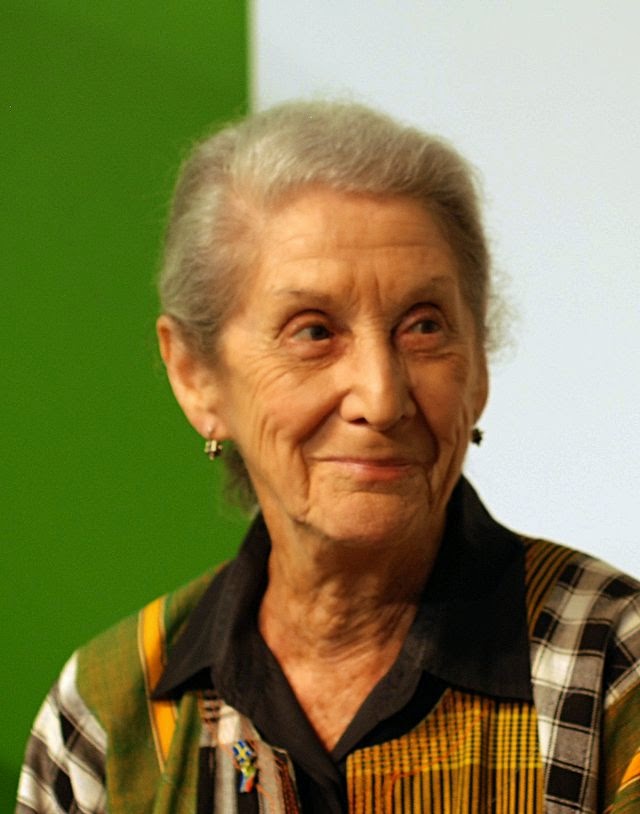Nadine
Gordimer, South Africa’s first Nobel laureate for literature, died on the 13th
July at the age of 90. She was a
political activist all her life, but her protests were directed where she felt
things were wrong, not by any political agenda.
She was a friend of Nelson Mandela and greatly admired him, and she supported his successor, President Thabo Mbeki, but she was strongly
outspoken about his AIDS denialist policy. She organized writers in South
Africa to oppose the recent law here which restricts newspaper reporting under
the 1984esque titled Protection of
Information Bill. (I wrote about it
at the time in No News is Good News.)
She refused to compromise on her principles. Ever. She demanded that her name
be removed from the short list for the Orange Prize for literature because it
is only open to woman writers.
The day
after she died, I heard an interview about her with one of the younger literary
fiction writers in South Africa who knew her and whom she helped. One of the questions he was asked was whether
her writing would last, given that it was so much set in the political era of
Apartheid and the struggle against it.
Of course he said that her writing would transcend its context, but I
thought it was a fair question.
Motivated by that question as well as her death, I reread July’s People. I chose that particular
book because its backstory is an apocalyptic collapse of Apartheid through a
black revolution with support from Zimbabwe, Mozambique, and the communist
states. It was published in 1981 and
such a scenario seemed anything but farfetched at the time. When the book was published in the US, a
review in the New York Times said: “Since Nadine Gordimer writes more knowingly
about South Africa than anyone else, this may be history in the making we are
reading.” The book was immediately
banned in South Africa as subversive.
After the new government it was accorded the status it deserved, but in
2001 one of the provincial education departments removed it from the school
reading list describing it as “deeply racist, superior and patronizing.” If you’re making everyone unhappy, you must
be doing something right!
The July of
the title is a gardener for a reasonably well-off liberal white family living
in Johannesburg. Of course that’s not
his real name, but we don’t learn that until three quarters of the way into the
book. He has worked for them for many
years, initially illegally because of the abominable pass system. He is regarded
as 'one of the family'. That is, from
the perspective of his employers, the Smales – husband, wife and three
young children. The adults toy with
emigrating, but just don’t get around to it.
When the rioting and fighting approaches their neighborhood, they know
they have to leave, but have nowhere to go.
July says they can come to his home where his family lives in the
country. When the story opens, the five
Smales find themselves in a round hut with nothing but the few things they managed to grab as they fled and a single bed.
This much I
remember from the first time I read the book many years ago. What I didn’t recall as clearly was the relationships
that developed between the participants in the village – July, Maureen and Bam
Smale, the children – differently depending on their ages – and their
counterparts in the village. Bam comes
with a yellow ‘bakkie’ – a small van – and a shotgun. These are status. All the rest is based on the historical relationship
between servant and employer and between cultures that think and behave very
differently. How much do the Smales know
about the man who works for them – this ‘member of the family’ - about his
background, his real family? How much do they really want to know? How much does anyone from one culture and
social group want to know about others beyond polite friendliness and mild
curiosity?
Many novels
have been written about this ranging from amusing to tragic. I can’t think of any one where the
relationship is exposed in this way through enforced integration into the poor
rural culture. Now I can’t think of any
other way you could do it as well. (Of course
it takes a genius to see that in the first place.) The relationships are laced with the racial
background, of course, but that is almost secondary to the cultural one. I think of the people who work at my townhouse complex
and how little I really know about them.
This writing is as true today as it was thirty years ago. So I have my answer.
Hamba
Kahle, Nadine. You will not be
forgotten.
Michael -
Thursday






















































